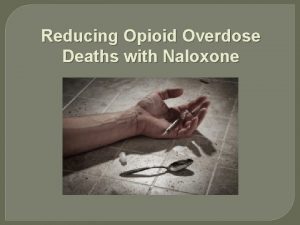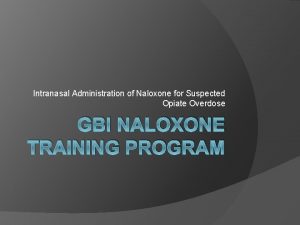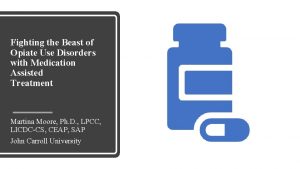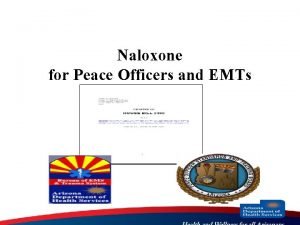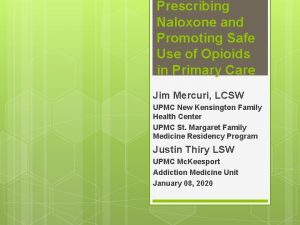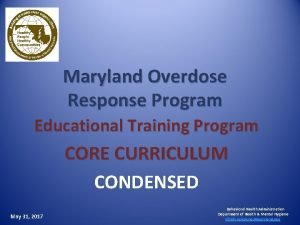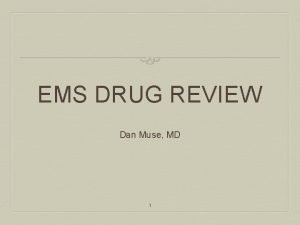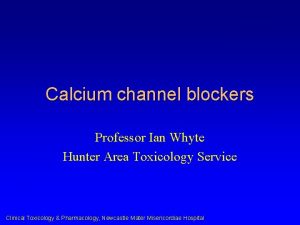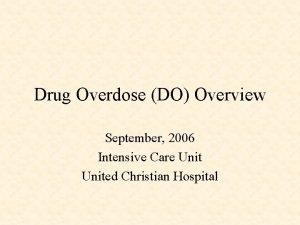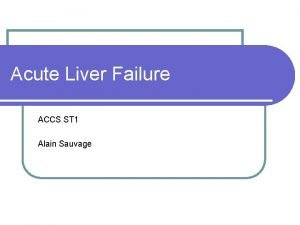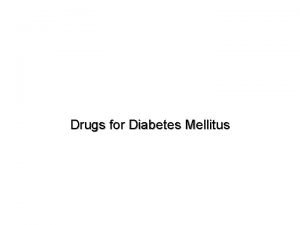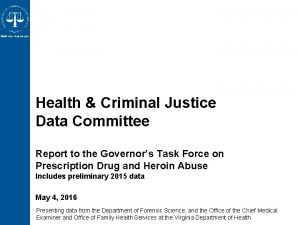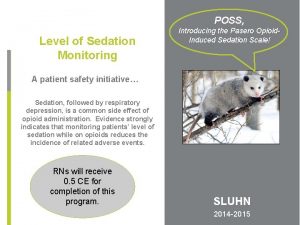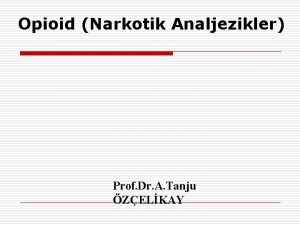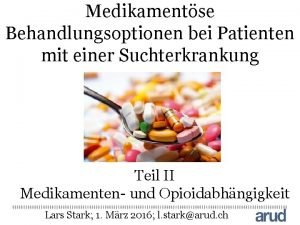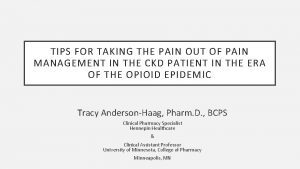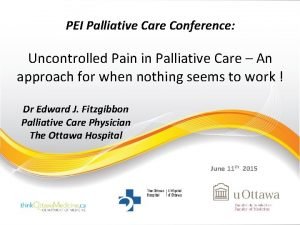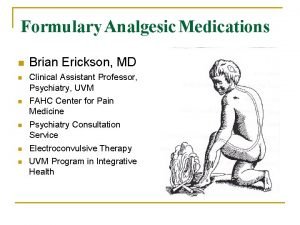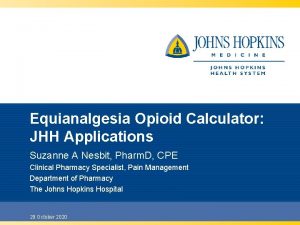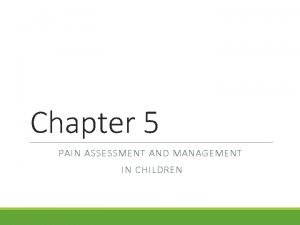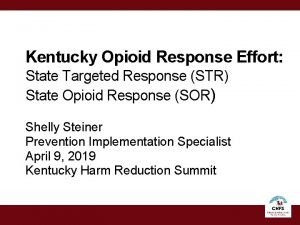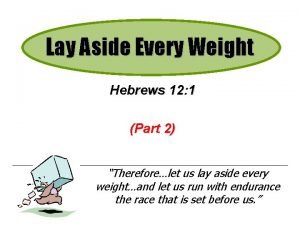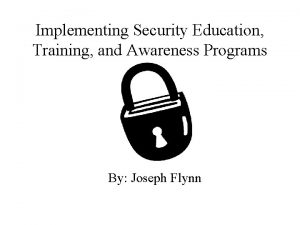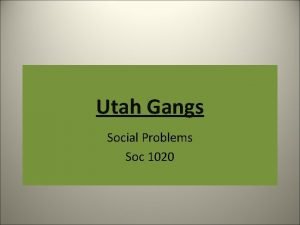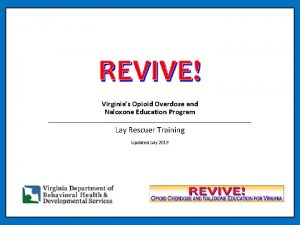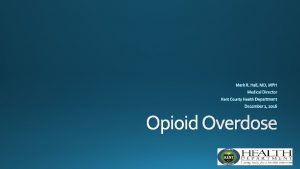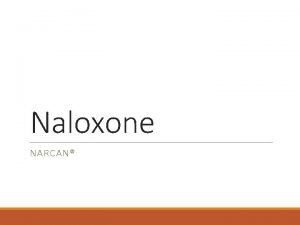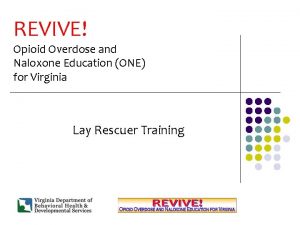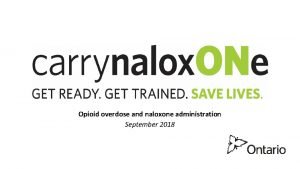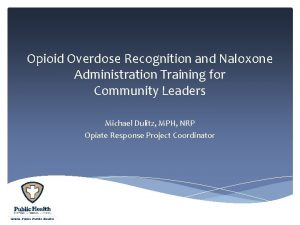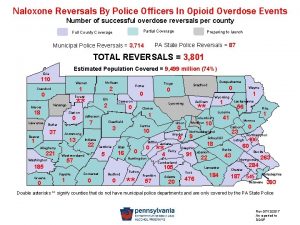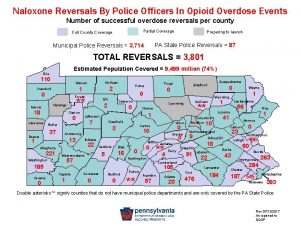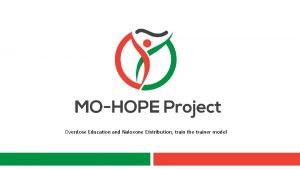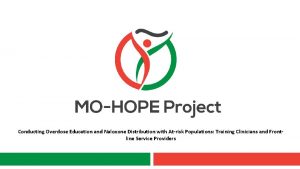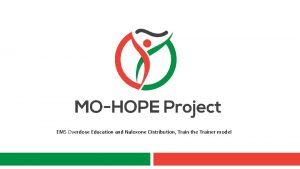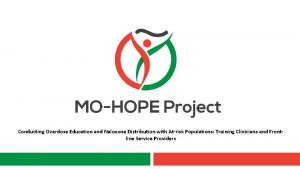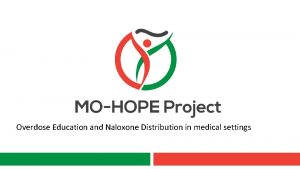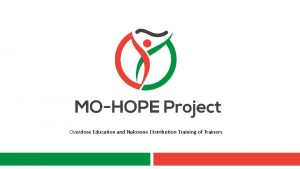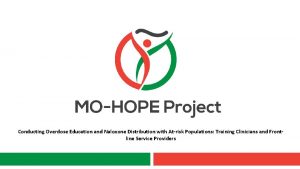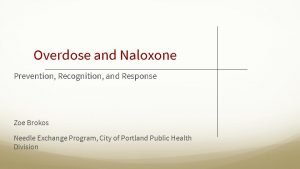Virginias Opioid Overdose and Naloxone Education Program Lay








































- Slides: 40

Virginia’s Opioid Overdose and Naloxone Education Program Lay Rescuer Training Updated July 2020

Learning Objectives l l l l Understand the REVIVE! program and legislation Understand addiction Understand how opioid overdose emergencies happen and how to recognize them Understand how naloxone works Identify risk factors that may make someone more susceptible to an opioid overdose emergency Dispel common myths about how to reverse an opioid overdose Learn how to respond to an opioid overdose emergency with the administration of naloxone

The Case for Naloxone Education Since 2013, fatal drug overdose has been the leading method of unnatural death in Virginia, surpassing all other forms of unnatural death including homicide, suicide, motor vehicles accidents, and undetermined deaths. In 2019, there were 1, 289 deaths from all-opioids which includes all versions of fentanyl, heroin, prescription opioids and U-47700 (an illicitly manufactured synthetic opioid).

Legal Protections in Overdose Response Virginia’s Good Samaritan Law (applies to any lay rescuers responding to overdose) Any person who: 21. In good faith administers naloxone or other opioid antagonist used for overdose reversal to a person who is believed to be experiencing or about to experience a life-threatening opioid overdose in accordance with the provisions of subsection Z of § 54. 1 -3408 shall not be liable for any civil damages for any personal injury that results from any act or omission in the administration of naloxone or other opioid antagonist used for overdose reversal, unless such act or omission was the result of gross negligence or willful and wanton misconduct. Subsection Z of § 54. 1 -3408: Z. A person who is not otherwise authorized to administer naloxone or other opioid antagonist used for overdose reversal may administer naloxone or other opioid antagonist used for overdose reversal to a person who is believed to be experiencing or about to experience a lifethreatening opioid overdose.

Safe Reporting of Overdoses (applies to people involved in an overdose situation) § 18. 2 -251. 03 Arrest and prosecution when experiencing or reporting overdoses No individual shall be subject to arrest or prosecution for • the unlawful purchase, possession, or consumption of alcohol pursuant to § 4. 1 -305, • possession of a controlled substance pursuant to § 18. 2 -250, • possession of marijuana pursuant to § 18. 2 -250. 1, intoxication in public pursuant to § 18. 2 -388, • or possession of controlled paraphernalia pursuant to § 54. 1 -3466 if: 1. Such individual (i) in good faith, seeks or obtains emergency medical attention (a) for himself, if he is experiencing an overdose, or (b) for another individual, if such other individual is experiencing an overdose, or (ii) is experiencing an overdose and another individual, in good faith, seeks or obtains emergency medical attention… 2. Such individual remains at the scene of the overdose or at any alternative location to which he or the person requiring emergency medical attention has been transported until a law-enforcement officer responds to the report of an overdose. If no law-enforcement officer is present at the scene of the overdose or at the alternative location, then such individual shall cooperate with law enforcement as otherwise set forth herein; 3. Such individual identifies himself to the law-enforcement officer who responds to the report of the overdose; and 4. The evidence for the prosecution of an offense enumerated in this subsection was obtained as a result of the individual seeking or obtaining emergency medical attention. Note: C. The provisions of this section shall not apply …during the execution of a search warrant or during the conduct of a lawful search or a lawful arrest.

The Standing Order and Naloxone Access A standing order has been issued for the State of Virginia allowing for individuals to go to any pharmacy to purchase naloxone without first obtaining a prescription from your doctor. Naloxone can be obtained from: Local health departments (no-cost) Community services boards (no-cost) Community pharmacies (insurance or out of pocket payment) ****Call your health department or community services board before going to ask about naloxone availability. ****

Understanding Addiction People don't plan to get addicted to drugs. When people first take a drug, they might like how it makes them feel. They believe they can control how much and how often they take the drug. But drugs can take away people’s control. Drugs can change the brain. Addiction refers to substance use disorders at the severe end of the spectrum and is characterized by a person’s inability to control the impulse to use drugs even when there are negative consequences. https: //easyread. drugabuse. gov/content/what-addiction

Nuggets Video Courtesy of Filmbuilder and Friends. Online the video can be accessed at https: //youtu. be/HUng. Lg. GRJpo


Common Opioids Generic Trade Street Hydrocodone Lortab, Vicodin Hydro, Norco, Vikes Oxycodone Oxycontin, Percocet Ox, Oxys, Oxycotton, Kicker, Hillbilly Heroin Morphine Kadian, MSContin M, Miss Emma, Monkey, White Stuff Codeine Tylenol #3 Schoolboy, T-3 s Fentanyl Duragesic Apache, China Girl, China White, Goodfella, TNT Carfentanil Wildnil Drop Dead, Flatline, Lethal Injection, Hydromorphone Dilaudid Oxymorphone Opana Meperidine Demerol Dillies, D, Juice Methadone Dolophine, Methadose Meth, Junk, Fizzies, Dolls, Jungle Juice Heroin Diacetylmorphine Dope, Smack, Big H, Black Tar, Dog Food Buprenorphine Bunavail, Suboxone, Subutex, Sobos, Bupe, Stops, Oranges Tramadol Ultram, Con. Zip Chill Pills, Trammies, Ultras Dill, Dust, Footballs, D, Big-D, M-2, M-80 s, Crazy 8 s, Super 8 s Blue Heaven, Octagons, Oranges, Pink Heaven, Stop Signs

What Is an Opioid Overdose? Opioid

What are risk factors that can make someone more likely to experience an overdose?

Risk Factors for Opioid Overdose Certain people are at higher risk for opioid overdose emergencies, including: • Prior Overdose • Reduced tolerance – previous users who have stopped using due to abstinence, illness, treatment, or incarceration • Mixing drugs – combining opioids with other drugs, including alcohol, stimulants or depressants. Combining stimulants and depressants DO NOT CANCEL EACH OTHER OUT • Using alone • Variations in strength or quantity or changing formulations (e. g. , switching from quick acting to long lasting/extended release) • Medical conditions such as chronic lung disease or kidney or liver problems

How can you tell the difference between someone who is high and someone who has overdosed?

Signs of an Opioid Overdose Really High Overdosed Muscles become relaxed Face is very pale or clammy Speech is slowed or slurred Breathing is infrequent or has stopped Sleepy-looking, “nod out” Deep snoring or gurgling (death rattle) Responsive to shouting, sternal rub or ear lobe pinch Unresponsive to any stimuli Normal heart rate and/or pulse, Normal skin tone Slow or no heart rate and/or pulse Pupils will contract and appear small “pinpoint pupils” For lighter skinned people, the skin tone turns bluish purple, for darker skinned people, it turns grayish or ashen. If someone is making unfamiliar sounds while “sleeping” it is worth trying to wake him or her up. Many loved ones of users think a person was snoring, when in fact the person was overdosing. These situations are a missed opportunity to intervene and save a life.

What are some myths you have heard about ways to reverse an opioid overdose?

Myths on Overdose Response There are many myths about how to reverse an opioid overdose. Here are some, and why you SHOULD NOT DO THEM. • DO NOT put the individual in a bath. They could drown. • DO NOT induce vomiting or give the individual something to drink. They could choke. • DO NOT put the person in an ice bath or put ice in their clothing or in any bodily orifices. Cooling down the core temperature of an individual who is experiencing an opioid overdose emergency is dangerous because it can further depress their heart rate. • DO NOT try and stimulate the individual in a way that could cause harm, such as slapping them hard, kicking them, or other more aggressive actions that may cause longterm physical damage. • DO NOT inject them with any foreign substances (e. g. , salt water or milk) or other drugs or force them to eat or drink anything. It will not help reverse the overdose and may expose the individual to bacterial or viral infection, abscesses, endocarditis, cellulitis, choking, etc.

Naloxone is the only effective response to an opioid overdose emergency!


How Naloxone Works Opioid Naloxone Opioid receptor Naloxone has a stronger affinity to the opioid receptors than the opioid, so it knocks the opioid off the receptors for a short time (30 -90 minutes) and lets the person breathe again.

Narcan Nasal Spray 2 doses in each kit

Evzio Auto-Injector 2 doses in each kit Pull EVZIO from the outer case. Do not go to Step 2 (Do not remove the red safety guard. ) until you are ready to use EVZIO. If you are not ready to use EVZIO, put it back in the outer case for later use. Pull off the red safety guard. To reduce the chance of an accidental injection, do not touch the black base of the auto-injector, which is where the needle comes out. If an accidental injection happens, get medical help right away. Note: The red safety guard is made to fit tightly. Pull firmly to remove. Do not replace the red safety guard after it is removed. Place the black end against the middle of the outer thigh, through clothing (pants, jeans, etc. ) if necessary, then press firmly and hold in place for 5 seconds. Note: The needle will inject and then retract back up into the EVZIO autoinjector and is not visible after use.

Injectable naloxone This class does not teach how to administer the injection • • • Use a long needle: Virginia requires a (3 m. L) syringe with 23 -25 gauge and 1 -1. 5 inch intramuscular (IM) needle If available, clean the skin with an alcohol swab first. It is ok, to inject through clothing if necessary. 90° angle to make sure you reach the muscle

How to Store Naloxone • Naloxone has a shelf life of approximately 2 years (check the label on your product. ) Store between 59°F to 77°F. • Naloxone may be stored for short periods up to 104°F. • Do not store naloxone in the car on hot summer days. • Do not freeze or leave naloxone in a car during the winter. • Naloxone may not be as effective if it is not stored properly. Only discard the naloxone once you have a replacement for it. If you don’t replace naloxone before it is needed, it is better to use it, even if it hasn’t been stored properly. • Naloxone does no harm when expired, so you may use an expired dose in an emergency if new doses are not available. • Store in a dark place and protect from light. • Keep out of reach and sight of children.

Safety of Naloxone Serious side effects from naloxone use are very rare. Using naloxone during an overdose far outweighs any risk of side effects. If the cause of the unconsciousness is uncertain, giving naloxone is not likely to cause further harm to the person. Reported side effects are often related to acute opioid withdrawal. Naloxone will not reverse overdoses from other drugs, such as alcohol, benzodiazepines, cocaine, or amphetamines. Naloxone has no abuse potential. Naloxone has the same dose for an adult and a child.

Steps to Respond to an Opioid Overdose 1. Check for Responsiveness 2. Call 911, if you must leave the individual alone, place them into recovery position. 3. Give 2 Rescue Breaths (if the person is not breathing) 4. Administer Naloxone 5. Continue Rescue Breathing 6. Assess and respond based on outcome of first naloxone administration **If you must leave an unresponsive person at anytime, put them in recovery position**

1. Check for Responsiveness • Try to stimulate them. You can shout their name, tap their shoulder, or pinch their ear lobe. • Give a sternum rub. Make a fist and rake your knuckles hard up and down the front of the person’s sternum (breast bone). This is sometimes enough to wake the person up. • Check for breathing. Put your ear to the person’s mouth and nose so that you can also watch their chest. Feel for breath and watch to see if the person’s chest rises and falls. • If the person does not respond or is not breathing, proceed to step 2

2. Call 911 Calling 911 immediately when responding to an overdose is vital. An individual who has overdosed needs to be assessed by medical professionals. • If there is more than one person around instruct another individual to call 911. • If with a cell phone call 911, put call on “speakerphone” and place phone on the ground. • Report that the person’s breathing has slowed or stopped, he or she is unresponsive, it is a suspected overdose, and give the exact location.

Recovery Position If you need to leave the person to get your naloxone kit or for any other reason put them into recovery position. Using Recovery Position: a. b. c. d. e. f. Place the overdose victim flat on their back. Roll the person over slightly onto their side. Bend their top knee. Put the person’s top hand under their head This position should keep the person from rolling onto their stomach or back and prevent them from asphyxiation in case of vomiting. Make sure the person is accessible and visible to first responders; don’t close or lock doors that would keep first responders from being able to find or access the person.

3. Give 2 Rescue Breaths 1. Place the person on their back. 2. Tilt their chin up to open the airway. 3. Plug their nose with one hand, and give 2 even, regular-sized breaths. Blow enough air into their lungs to make their chest rise. If you don’t see their chest rise out of the corner of your eye, tilt the head back more and make sure you’re plugging their nose.

4. Administer Naloxone usually starts working within 30 -45 seconds after it is given, but we give the person up to 3 minutes to respond. While you wait for naloxone to take effect, immediately begin Step 5.

5. Rescue Breathing or CPR (if rescuer is CPR trained or instructed to do so by 911) 1. Place the person on their back. 2. Tilt their chin up to open the airway. 3. Plug their nose with one hand, and give 2 even, regular-sized breaths. Blow enough air into their lungs to make their chest rise. If you don’t see their chest rise out of the corner of your eye, tilt the head back more and make sure you’re plugging their nose. 4. Repeat, give 1 breath every 5 seconds. PLEASE NOTE - You may have heard that recent CPR guidelines recommend “hands-only CPR, ” or only chest compressions instead of rescue breathing and chest compressions. These guidelines are for layperson response to cardiac arrest, and NOT overdose. It is still recommended that you perform rescue breathing for an overdose, where the primary issue is respiratory depression, and not cardiac arrest. Brain damage can occur after three to five minutes without oxygen. Rescue breathing gets oxygen to the brain quickly. Once you give naloxone, it may take some time for it to be take effect, so the person may not start breathing on their own right away. Continue rescue breathing/cpr for them until the naloxone takes effect or until emergency medical services arrive.

6. Assess and Respond Most individuals will recover after a single dose of naloxone is administered. Ideally, while performing Step 5 the person will begin breathing on their own. However, there are two cases in which you may need to administer a second dose of naloxone: • SITUATION A: If the individual has not responded to the initial dose within three minutes • SITUATION B: If the individual has relapsed into an overdose again after having previously recovered with the initial dose.

When to give a 2 nd dose of naloxone SITUATION A: The individual has not responded to the initial dose within three minutes When this occurs: • Naloxone should take effect within 30 -45 seconds but may take longer • Wait three minutes (continue rescue breathing/cpr during this time) • At three minutes, if still no response, administer second dose of naloxone • If person remains unresponsive after the second dose is administered, continue rescue breathing/cpr until emergency medical services arrives.

When to give a 2 nd dose of naloxone SITUATION B: The individual has relapsed into an overdose again after having previously recovered with the initial dose. Naloxone has a very short half life – 30 -90 minutes. In some cases, there is so much opioid in the system that the person can relapse back into overdose after the naloxone has worn off. If this occurs: • Repeat steps 1 through 5 • Continue rescue breathing/cpr until person medical services arrives. Opioid recovers or until emergency Naloxone Opioid receptor Naloxone has a stronger affinity to the opioid receptors than the opioid, so it knocks the opioid off the receptors for a short time (30 -90 minutes) and lets the person breathe again.

Aftercare of a Recovered Person People wake up from an overdose differently. While people are often confused anxious, they are rarely violent or combative. This is a person in psychological distress. Many times when people overdose they don’t realize what has happened. Explain what happened and emphasize the importance of waiting for emergency medical services to arrive so they can be assessed. If the person is dependent on opioids they will be in withdrawal since opioids cannot attach to receptors while naloxone is present – even if they take more drugs it will not help. Let them know that once naloxone wears off they could potentially relapse into an overdose again if opioids are still in their system.

Hands-On Training Take this time to practice mock scenarios responding to opioid overdoses. 1. Check for Responsiveness 2. Call 911, if you must leave the individual alone, place them into recovery position. 3. Give 2 Rescue Breaths (if the person is not breathing) 4. Administer Naloxone 5. Continue Rescue Breathing 6. Assess and respond based on outcome of first naloxone administration

REVIVE! Kits • 2 Pairs of Vinyl Gloves • 2 Pocket Face Shield • 2 “Naloxone Has Been Given” Stickers • 1 Instruction Card • 1 Canvas Carrying Case If you use your REVIVE! training let us know using the link found on the instruction card in your kit!

Thanks for your attendance! For more information: REVIVE@dbhds. virginia. gov http: //www. dbhds. virginia. gov/individuals-and-families/substanceabuse/revive Complete the evaluation for today’s training! https: //ww. surveymonkey. com/r/SGL 3 NCX

Acknowledgements REVIVE! would not be possible without the help of many public and private partners, who DBHDS would like to acknowledge for their invaluable assistance: Boston Public Health Commission Bureau of Justice Assistance Chicago Recovery Alliance The Chris Atwood Foundation Delegate John O’Bannon, R-73 Joanna Eller Harm Reduction Coalition The Mc. Shin Foundation Massachusetts Department of Public Health Multnomah County (OR) Health Department New York City Department of Mental Health and Hygiene New York State Division of Criminal Justice Services Ed Ohlinger One Care of Southwest Virginia Project Lazarus SAARA Recovery Center of Virginia San Francisco Department of Health/DOPE Project University of Washington Alcohol and Drug Abuse Institute Virginia Department of Criminal Justice Services Virginia Department of Health Professions The Virginia Harm Reduction Coalition
 Opioid overdose
Opioid overdose Opioid overdose
Opioid overdose Opioid overdose
Opioid overdose Lay lay lay jack
Lay lay lay jack Define narcan
Define narcan Naloxone mechanism
Naloxone mechanism Amphastar nasal naloxone instructions
Amphastar nasal naloxone instructions Biết lấy gì cảm mến biết lấy chi báo đền
Biết lấy gì cảm mến biết lấy chi báo đền Vitamin b6 overdose
Vitamin b6 overdose Tricyclic antidepressants overdose
Tricyclic antidepressants overdose Magnesium overdose
Magnesium overdose Beta-blocker overdose treatment glucagon
Beta-blocker overdose treatment glucagon Normal range calcium
Normal range calcium Zoplicone overdose
Zoplicone overdose Acute liver failure
Acute liver failure Metformin overdose
Metformin overdose Nys dcjs forms
Nys dcjs forms Functions of vitamin a
Functions of vitamin a Too much caffeine symptoms
Too much caffeine symptoms Rass vs poss
Rass vs poss Opioid zehirlenmesi
Opioid zehirlenmesi Ecotussin
Ecotussin Types of pain
Types of pain Mechanism of action of opioid analgesics
Mechanism of action of opioid analgesics Non-opioid
Non-opioid Opioid receptors location
Opioid receptors location Brian erickson md
Brian erickson md Equianalgesia
Equianalgesia Non-opioid
Non-opioid Kentucky opioid response effort
Kentucky opioid response effort Bird riddles
Bird riddles Nature and nature's law lay hid in night meaning
Nature and nature's law lay hid in night meaning Lay aside every weight sermon
Lay aside every weight sermon I am covered in dry scales and i lay eggs. what am i?
I am covered in dry scales and i lay eggs. what am i? Difference between als and formal education
Difference between als and formal education Difference between health education and health promotion
Difference between health education and health promotion Rockefeller college professional development program
Rockefeller college professional development program Seta program 5 steps
Seta program 5 steps Sequential program and an event-driven program
Sequential program and an event-driven program Lay to rest
Lay to rest Tracy swena
Tracy swena
